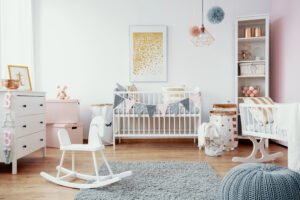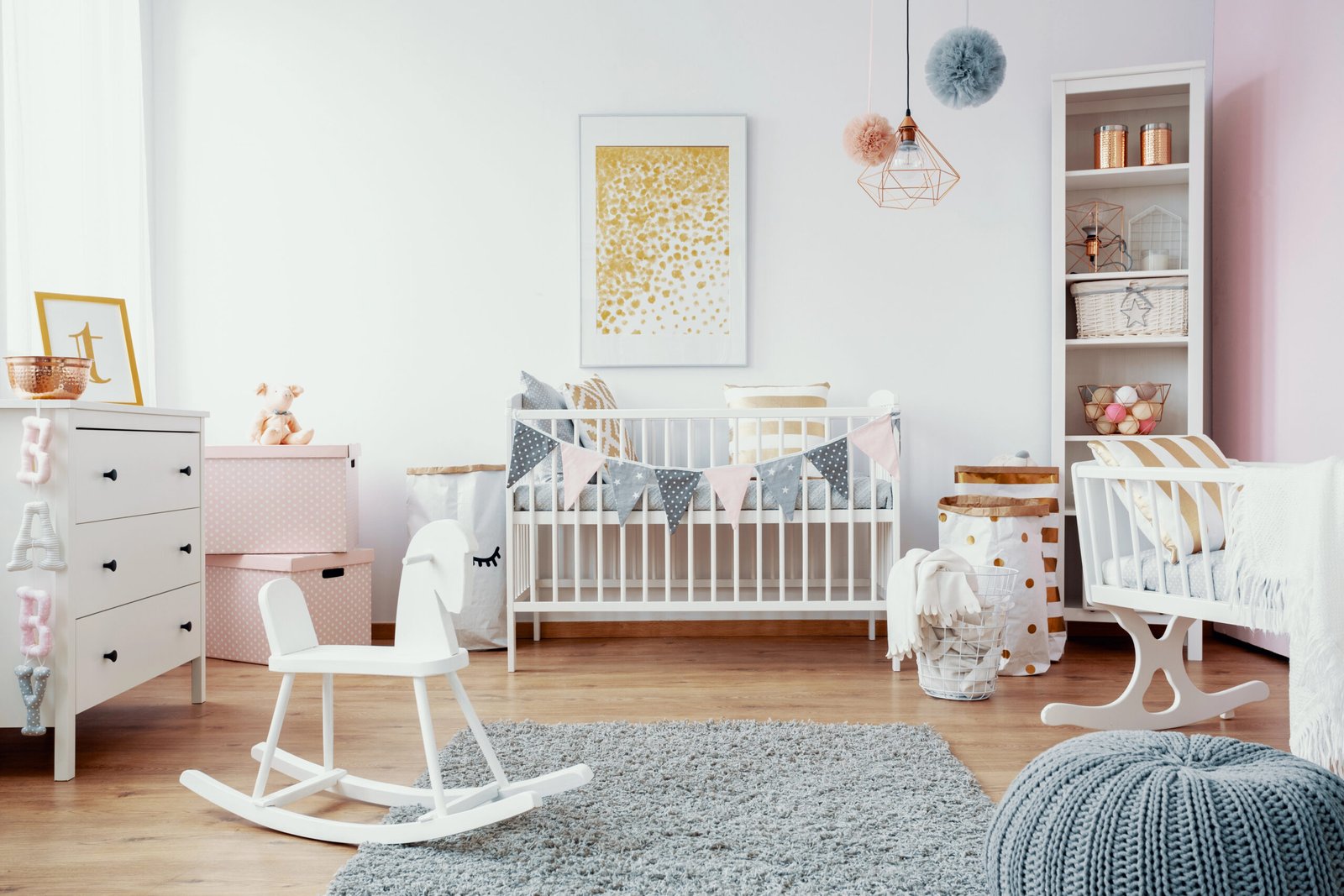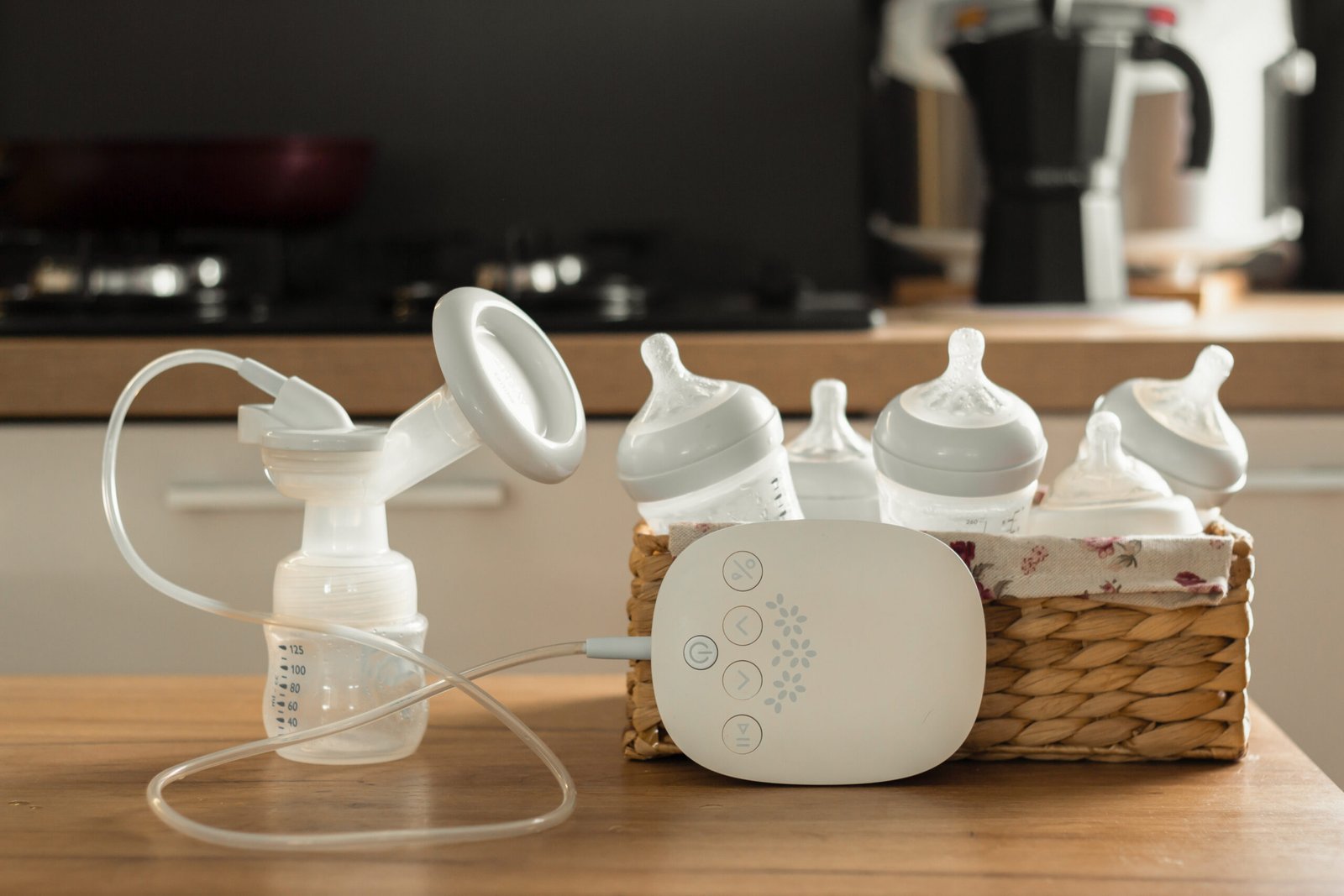Timing Your Nursery Preparation

The ideal time to prepare your home for a newborn varies by family, but most experts recommend beginning the process during the second trimester or early in the third trimester. This timeline provides several advantages:
1. Energy levels: Many pregnant women experience a surge of energy during the second trimester, making it an ideal time for planning and organizing
2. Nesting instinct: The natural “nesting” urge often kicks in during the third trimester, providing motivation for final preparations
3. Baby shower timing: This period typically aligns with baby showers, allowing you to incorporate gifts into your nursery setup
4. Avoiding last-minute stress: Completing preparations before the final weeks of pregnancy helps reduce stress as your due date approaches
5. Physical comfort: Earlier preparation avoids the physical discomfort of setting up furniture and organizing spaces during late pregnancy
However, there is no “perfect” time that works for everyone. Some parents begin planning their nursery as soon as they learn they’re expecting, while others wait until after the baby arrives to finalize their setup. The most important consideration is creating a timeline that works for your specific circumstances and reduces stress during this important transition.
Essential Nursery Components
Safe Sleep Space
The foundation of any nursery is a safe sleeping environment for your baby. Current safety guidelines recommend:
1. Crib or bassinet: Must meet current safety standards with a firm, flat mattress that fits snugly without gaps
2. Mattress: Firm surface covered with a fitted sheet only (no loose bedding, pillows, bumpers, or stuffed animals)
3. Sleep location: Ideally in the parents’ room for the first 6-12 months, but within a separate sleep space (not bed-sharing)
4. Sleep position: Always place babies on their backs to sleep
5. Sleep environment: Keep the room at a comfortable temperature (68-72F/20-22C) and ensure adequate air circulation
When selecting a crib or bassinet, look for products that are labeled as “crib,” “portable crib,” “bassinet,” or “play yard” and meet current safety certifications. Avoid using older cribs that may not meet current safety standards, particularly those with drop sides, which have been banned since 2011.
Changing Area
A dedicated changing area helps make diaper changes more efficient and comfortable. Options include:
1. Changing table: A purpose-built piece of furniture with raised sides for safety
2. Dresser with changing pad: A more versatile option that can transition to regular use as your child grows
3. Portable changing station: For smaller spaces or to supplement a primary changing area
Essential components for any changing area include:
– Changing pad with safety strap: Securely attached to the furniture according to manufacturer guidelines
– Changing pad covers: At least 2-3 washable covers for inevitable messes
– Diaper caddy: Keeps supplies organized and within reach
– Diaper disposal system: Either a specialized diaper pail or a regular trash can with lid
– Nightlight: For visibility during nighttime changes without disrupting sleep
Feeding Station
Whether you plan to breastfeed, bottle-feed, or use a combination approach, a comfortable feeding station is essential. Key components include:
1. Comfortable chair: A glider, rocker, or recliner where you can comfortably sit for extended periods
2. Side table: To hold water, snacks, phone, and feeding supplies
3. Supportive pillows: Nursing pillows or regular pillows to support your arms and back
4. Footstool: To elevate your legs and improve posture during feeding sessions
5. Lighting: Soft, adjustable lighting for nighttime feedings that won’t fully wake the baby
6. Burp cloths: Easily accessible for quick cleanups
For parents who plan to pump breast milk, consider adding:
– Small table or cart: To hold the breast pump and supplies
– Electrical outlet access: For electric pumps
– Storage containers: For collected milk
– Mini-fridge: Optional but convenient for overnight pumping sessions
Storage Solutions
Effective storage is crucial for maintaining an organized nursery. Consider these options:
1. Dresser: For clothing, with drawer organizers to separate small items
2. Closet organization: Hanging rod with size dividers, shelving for folded items, and bins for accessories
3. Bookshelf or wall shelves: For books, monitor, sound machine, and decorative items
4. Under-crib storage: For items used less frequently
5. Toy storage: Baskets, bins, or toy chests that are easy to access and maintain
6. Laundry hamper: Dedicated space for baby’s laundry
Organizational tips for maximizing nursery storage:
– Use drawer dividers for organizing small clothing items by type or size
– Install closet dividers to separate clothing by size
– Label bins and baskets for easy identification
– Create zones for different activities (sleeping, changing, feeding, playing)
– Consider vertical storage options to maximize floor space
Environmental Controls
Creating a comfortable environment helps promote better sleep and overall well-being for your baby:
1. Sound machine: Provides consistent background noise to mask household sounds and promote better sleep
2. Room-darkening window coverings: Helps establish healthy sleep patterns by controlling light exposure
3. Humidifier: A cool-mist humidifier can help maintain optimal humidity, especially during winter months or in dry climates
4. Air purifier: Optional but beneficial for improving air quality, especially in urban areas or homes with pets
5. Thermometer: To monitor room temperature and ensure it stays within the recommended range
Monitoring System
A reliable monitoring system provides peace of mind when you’re not in the same room as your baby:
1. Audio monitor: Basic option that allows you to hear your baby
2. Video monitor: Provides visual and audio monitoring
3. Smart monitors: Advanced options that may track breathing, sleep patterns, or room conditions
4. Monitor placement: Position the camera to view the crib without cords being within reach of the baby
Creating a Nursery in Limited Space
For families with space constraints, these strategies can help create a functional nursery within a smaller footprint:
Room-Sharing Solutions
When sharing your bedroom with your baby:
1. Bassinet or mini-crib: Takes up less space than a full-sized crib
2. Wall-mounted storage: Shelving above the bassinet for essentials
3. Rolling cart: Mobile storage that can be moved as needed
4. Under-bed storage: For items used less frequently
5. Door-hanging organizers: Utilize vertical space for storage
6. Sound machine placement: Position between parent and baby sleeping areas to mask noise
Multi-Purpose Furniture
Maximize functionality with furniture that serves multiple purposes:
1. Crib with attached changing table: Combines two essential pieces
2. Dresser as changing table: Add a changing pad to the top of a dresser
3. Storage ottoman: Provides seating and storage
4. Convertible furniture: Cribs that convert to toddler beds, changing tables that become desks
5. Wall-mounted folding changing table: Can be folded up when not in use
Creating Zones in Shared Spaces
When a dedicated nursery isn’t possible:
1. Use room dividers: Screens, curtains, or bookshelves to create a visual separation
2. Define zones with rugs: Area rugs help visually separate baby’s space
3. Consistent color scheme: Integrate baby items into your existing decor with a cohesive color palette
4. Vertical thinking: Utilize wall space with floating shelves and hanging organizers
5. Dual-purpose decor: Choose items that serve both functional and decorative purposes
Baby-Proofing Your Home
While newborns aren’t mobile, preparing your home for safety early establishes good habits before they’re needed:
Basic Safety Measures
1. Smoke and carbon monoxide detectors: Ensure working detectors on every level of your home
2. Outlet covers: Install on all accessible outlets
3. Furniture anchoring: Secure tall furniture to walls to prevent tipping
4. Cord management: Keep blind cords, electrical cords, and monitor cords out of reach
5. Water heater temperature: Set to 120F (49C) or lower to prevent scalding
6. Emergency information: Post emergency numbers and your address in a visible location
7. First aid kit: Stock with infant-appropriate supplies
Creating Safe Spaces
1. Crib placement: Away from windows, heaters, air conditioners, and cords
2. Changing table safety: Always use safety straps and never leave baby unattended
3. Bathroom safety: Install anti-scald devices on faucets and keep toilet lids closed
4. Kitchen safety: Consider safety latches for cabinets containing hazardous items
5. Pet considerations: Plan for safe interactions between pets and baby
Stocking Essential Supplies
Beyond furniture and equipment, having these supplies on hand before baby arrives helps ensure a smoother transition:
Clothing Essentials
1. Onesies/bodysuits: 7-10 in newborn and 0-3 month sizes
2. Sleepers/footie pajamas: 5-7 pairs
3. Socks/booties: 5-7 pairs
4. Hats: 2-3 for temperature regulation
5. Mittens: 2-3 pairs to prevent face scratching
6. Weather-appropriate outerwear: As needed for your climate
7. Swaddles: 3-4 swaddle blankets or swaddle sacks with Velcro or zipper closures
Diapering Supplies
1. Diapers: 2-3 packs of newborn size, 1 pack of size 1 (or cloth diaper supply)
2. Wipes: 2-3 packs of sensitive skin baby wipes
3. Diaper cream: 1-2 tubes of zinc oxide-based cream
4. Changing pad liners: Disposable or washable
5. Diaper pail and liners: For odor control
6. Portable changing pad: For diaper changes away from the changing table
Feeding Supplies
For all feeding methods:
1. Burp cloths: 8-10
2. Bibs: 5-7 for newborns
For bottle feeding (including expressed breast milk):
1. Bottles: 6-8 bottles with slow-flow nipples
2. Bottle brush: For thorough cleaning
3. Drying rack: Specifically designed for baby items
4. Formula: If using formula, have at least a one-week supply
For breastfeeding:
1. Nursing bras: 2-3
2. Breast pads: Disposable or washable
3. Nipple cream: For soreness
4. Nursing pillow: For positioning support
Bathing Supplies
1. Baby bathtub or sink insert: For safe bathing
2. Washcloths: 6-8 soft cloths
3. Hooded towels: 2-3
4. Baby wash/shampoo: Gentle, fragrance-free formulations
5. Baby lotion: Optional, fragrance-free
6. Soft brush: For cradle cap management
7. Bath thermometer: To ensure appropriate water temperature
Health and Grooming
1. Digital thermometer: Rectal thermometer for accurate readings in newborns
2. Nasal aspirator: For clearing congestion
3. Infant nail clippers or scissors: With rounded tips
4. Infant medicine dispenser: For any prescribed medications
5. Infant acetaminophen: Check with your pediatrician before administering
6. Gas relief drops: Optional, as recommended by your pediatrician
7. Petroleum jelly: For circumcision care if applicable
Comfort Items
1. Pacifiers: 2-3 if you choose to use them
2. Soft toys: 1-2 for visual stimulation (not for sleep)
3. Books: A few board books for early reading
4. Play mat: For supervised tummy time
5. Bouncer or swing: For supervised awake time
Preparing Other Family Members
Siblings
Help prepare older children for the new arrival:
1. Age-appropriate books: About becoming a big brother or sister
2. Involvement in preparations: Let them help set up the nursery in age-appropriate ways
3. Sibling gifts: Plan for a small gift from the baby to siblings
4. Maintaining routines: Plan how to maintain important routines after baby arrives
5. Special time: Arrange for one-on-one time with each child after baby arrives
Pets
Prepare pets for the changes ahead:
1. Gradual introduction to baby items: Let pets investigate nursery furniture, baby lotions, etc.
2. Sound acclimation: Play recordings of baby sounds
3. Routine changes: Gradually adjust walking or feeding schedules if they will change after baby arrives
4. Safe spaces: Create pet-only zones where they can retreat
5. Professional help: Consider consulting a pet behaviorist for specific concerns
Self-Care Preparation
Preparing for your own needs is just as important as preparing for your baby:
1. Postpartum recovery supplies: Maxi pads, perineal bottle, sitz bath, comfortable underwear
2. Comfortable clothing: Nursing-friendly if breastfeeding, loose-fitting for comfort
3. Meal preparation: Stock freezer with easy meals or arrange meal delivery
4. Support network: Identify friends and family who can help with specific tasks
5. Rest area: Create a comfortable space for your own rest and recovery
6. Resource list: Compile contact information for lactation consultants, postpartum doulas, and support groups
Final Preparations Before Baby’s Arrival
In the final weeks before your due date:
1. Wash baby clothes and linens: Use fragrance-free, baby-friendly detergent
2. Assemble furniture: Complete all assembly and ensure stability
3. Install car seat: Have installation checked by a certified technician
4. Pack hospital bag: Include items for baby’s homecoming outfit
5. Stock pantry and freezer: With easy-to-prepare meals and snacks
6. Create care stations: Set up diapering and feeding stations in multiple rooms
7. Test equipment: Ensure monitors, sound machines, and other devices work properly
8. Prepare pets: Make arrangements for pet care during your hospital stay
Sources:
– Hush Hush Little Baby, “New Year, New Baby: Essential Tips for Preparing for Your Newborn in 2025,” January 2025
– Taking Cara Babies, “Nursery Checklist,” January 2025
– Pampers, “Newborn Baby Checklist‚ÄîThe Must-Haves and More,” December 2024
– The Sweetest Escapes, “Baby Must Haves for Small Spaces and Travel in 2025,” January 2025
– Partum Health, “Baby nursery ideas: Doula-recommended decor for 2025,” January 2025
– Crane Baby, “Ultimate Baby Registry Checklist for 2025,” February 2025
– The Bump, “Nursery Checklist: The Essential Items,” 2024
– Nanit, “Nursery checklist: 20 must-have newborn essentials,” 2024
– Omega Pediatrics, “Preparing Your Home for a New Baby: The Ultimate Guide,” August 2024



